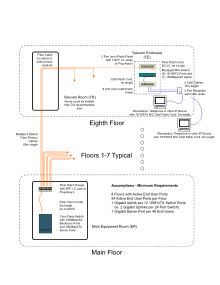Fiber to the telecom enclosure

Fiber to the telecom enclosure (FTTE), also sometimes called fiber to the zone (FTTZ),[1] or fibre to the cabinet (FTTC) in the UK is a standards-compliant structured cabling system architecture that extends the optical fiber backbone network from the equipment room, through the telecom room, and directly to a telecommunications enclosure (TE) installed in a common space to serve a number of users in a work area.
Implementation
Its implementation is based on the TIA-569-B “Pathways and Spaces” technical standard, which defines the Telecommunications Enclosure (TE), and TIA/EIA-568-B.1 Addendum 5, which defines the cabling when a TE is used. The FTTE architecture allows for many media choices from the TE to the work area; it may be balanced twisted pair copper, multi-mode optical fiber, or even wireless if an access point is installed in or near the TE.
Depending on the user’s needs, FTTE can be deployed in low-density or high-density configurations. A low-density system might use one or two inexpensive 8-port Ethernet mini-switches as an example (these switches have eight 10/100 Mbit/s Ethernet copper ports and one 1 Gbit/s Ethernet fiber uplink).
A high-density FTTE design might use commonly available 24- or 48-port switches (these switches are configured with one 1 Gbit/s uplink port per twelve 100BASE-TX user ports). This relatively high work area-to-backbone port ratio provides better performance than is typically provided to enterprise users. Both low and high-density FTTE architectures provide excellent performance in terms of bandwidth delivered to the work area.
Pros and cons
- Advantages
- Low Cost
- Non-blocking or low-blocking performance better supports convergence
- Extremely flexible to deploy; supports Moves, Adds & Changes
- Enables consolidation of electronics into a centralized Telecommunications Room
- Allows the use of a variety of media from the TE to the user
- Disadvantages
- TE location is near the user and must be secured
See also
- Fiber-optic communication
- Fiber in the loop
- Fiber to the x
- Hybrid fibre-coaxial
- BICSI
- Network architecture
References
- ↑ Hardy, Stephen (March 31, 2009). "FTTE battles for enterprise/SAN acceptance". Lightwave. PennWell Corporation.
External resources
- TIA Fiber Optic Standardization Subcommittees
- Fiber Optics LAN Section of the Telecommunications Industry Association
- Fiber Optics Association